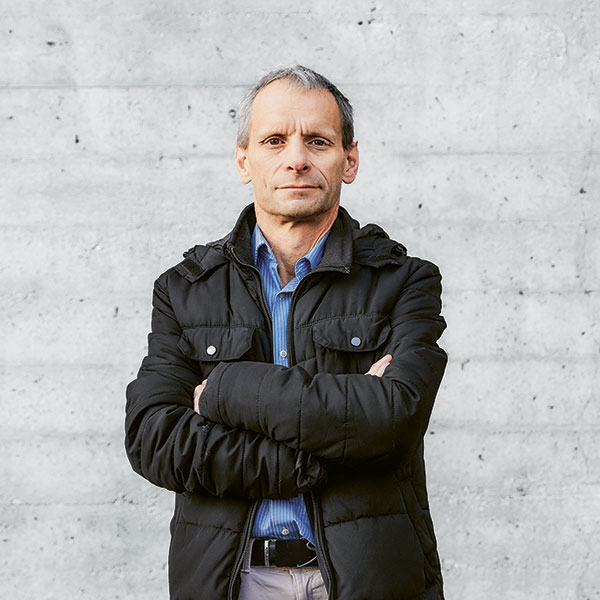Are moonshot initiatives just a PR tool?
Big tasks need big money from private investors – like rail travel at the speed of sound, a cancer breakthrough or a digitalised education system. But isn’t this really just about advertising?

Image: Valérie Chételat

Image: Valérie Chételat
In order to promote innovation, you need to bring together the biggest possible sums of money, which means bundling private and public funds. According to the prevailing opinion, innovation works like a big automaton. The more money you throw in the one end, the more innovation comes out the other. If only! But you can’t force these things with money. More money will lead to more conferences, more strategy papers, more analyses, publications and prototypes, but none of them can guarantee actually finding new solutions. Just because ‘innovation’ is mentioned doesn’t necessarily mean you’ll find any if you lift the lid.
The general rule is: the more grandiose the promises of innovation, the more you ought to mistrust them. Andreas Hieke is a German inventor who has been involved in several innovations from Silicon Valley, and he recently said in an interview with the Neue Zürcher Zeitung: “Everyone’s talking about innovation and disruption. But they always talk about them when they’re no longer actually happening”. That’s an astute observation. If moonshot initiatives are popping up out of the ground everywhere, they often degenerate into job-creation programmes or PR campaigns.
One such example is the Cancer Moonshot Initiative. In 2016 the biotech billionaire Patrick Soon-Shiong declared that he wanted to revolutionise the war on cancer by 2020. By putting together a coalition of renowned companies, researchers and doctors, he wanted to develop an effective vaccine against cancer. Today, four years later, independent medical researchers claim they’ve seen almost nothing of the initiative. If you check through the lists of clinical studies, presentations and press releases, you’ll start to suspect that they’re still far away from achieving the most important goals they set themselves.
This does not mean that moonshot initiatives are useless. They can certainly provide an important impetus for research. And it makes sense to bring together private and public monies in certain fields. But our politicians in particular are fond of believing that more funding always leads to more innovation, and it’s often a false conception. This is why you have to take a good hard look at what really lies behind a ‘moonshot initiative’.
Mathias Binswanger is a professor of economics at the University of Applied Sciences Northwestern Switzerland and the author of the book Der Wachstumszwang (The compulsion to growth).
The aim of the Cancer Moonshot Initiative was to bring about a massive acceleration in medical research. Back in 2016, the US Vice-President Joe Biden even said that this initiative could condense the progress of ten years into just five. Of course it’s also about getting a lot of PR. And that’s a risk. It can polarise things, it can distract us from newer strategies and can lead to intellectual homogeneity.
Nevertheless, moonshot initiatives have the potential to accelerate projects strategically – in a manner that is difficult, even impossible if you’re working only with public research monies. Without private moonshot initiatives, there’s just as big a risk that important ideas will never get beyond the development pipeline, and that you’ll never reach the necessary critical mass for their practical implementation.
The private Hyperloop Moonshot isn’t just about making Elon Musk’s potential clients happy. It’s also about creating conceptual building blocks that can then be used by other companies or even by public institutions. For example, EPFL achieved a fantastic third place in the Spacex Hyperloop Pod Competition in 2019, and has already profited from the design it published. Open-source designs are a far cry from the old concepts of intellectual property, like patents.
Often, the boundary between public and private interests can shift over time. The original moonshot was extremely successful, but it wasn’t private. It didn’t just fulfil its mission, but also created a whole list of collateral benefits for research, materials and infrastructure. The cost of the Space Shuttle became too high in the eyes of the general public, which is why it was mothballed. Manned moonshots will probably be funded privately in the future.
In computer science education, for example, Code.org has launched a private moonshot initiative in order to teach programming to all the children in the world. Forty million children have already taken part in our annual Hour of Code event, where even Barack Obama publicly wrote a program – the very first US President in history to do so. Code.org naturally also offers further training in teacher education – albeit at a price. But if this means that an unprecedented number of school students and teachers get a chance to engage with the topic of computer programming, then on principle, that’s a good thing. The massive PR and advertising expenditure that makes possible such a success is precisely what shouldn’t be paid for out of the public purse.
Alexander Repenning is the Hasler Professor and Chair of Computer Science Education at the School of Teacher Education at the University of Applied Sciences Northwestern Switzerland (PH FHNW) and a computer science professor at the University of Colorado. He also runs the initiative Scalable Game Design Switzerland.

Image: Valérie Chételat
When people talk about research initiatives, they usually lay it on thick. They toss about adjectives like ‘excellent’, ‘leading’, ‘cutting edge’, and ‘disruptive’. The ‘moonshot initiative’ is another one. The VPS Healthcare Abu Dhabi has one, the World Bank has one, and since 2019, Switzerland has had one too, namely the AI Moonshot Roundtable, which is a talent and research hub in the field of artificial intelligence. The aim is to give Zurich a leading role as a centre of business and research.
In order to promote innovation, you need to bring together the biggest possible sums of money, which means bundling private and public funds. According to the prevailing opinion, innovation works like a big automaton. The more money you throw in the one end, the more innovation comes out the other. If only! But you can’t force these things with money. More money will lead to more conferences, more strategy papers, more analyses, publications and prototypes, but none of them can guarantee actually finding new solutions. Just because ‘innovation’ is mentioned doesn’t necessarily mean you’ll find any if you lift the lid.
The general rule is: the more grandiose the promises of innovation, the more you ought to mistrust them. Andreas Hieke is a German inventor who has been involved in several innovations from Silicon Valley, and he recently said in an interview with the Neue Zürcher Zeitung: “Everyone’s talking about innovation and disruption. But they always talk about them when they’re no longer actually happening”. That’s an astute observation. If moonshot initiatives are popping up out of the ground everywhere, they often degenerate into job-creation programmes or PR campaigns.
One such example is the Cancer Moonshot Initiative. In 2016 the biotech billionaire Patrick Soon-Shiong declared that he wanted to revolutionise the war on cancer by 2020. By putting together a coalition of renowned companies, researchers and doctors, he wanted to develop an effective vaccine against cancer. Today, four years later, independent medical researchers claim they’ve seen almost nothing of the initiative. If you check through the lists of clinical studies, presentations and press releases, you’ll start to suspect that they’re still far away from achieving the most important goals they set themselves.
This does not mean that moonshot initiatives are useless. They can certainly provide an important impetus for research. And it makes sense to bring together private and public monies in certain fields. But our politicians in particular are fond of believing that more funding always leads to more innovation, and it’s often a false conception. This is why you have to take a good hard look at what really lies behind a ‘moonshot initiative’.
Mathias Binswanger is a professor of economics at the University of Applied Sciences Northwestern Switzerland and the author of the book Der Wachstumszwang (The compulsion to growth).

Image: Valérie Chételat
The aim of the Cancer Moonshot Initiative was to bring about a massive acceleration in medical research. Back in 2016, the US Vice-President Joe Biden even said that this initiative could condense the progress of ten years into just five. Of course it’s also about getting a lot of PR. And that’s a risk. It can polarise things, it can distract us from newer strategies and can lead to intellectual homogeneity.
Nevertheless, moonshot initiatives have the potential to accelerate projects strategically – in a manner that is difficult, even impossible if you’re working only with public research monies. Without private moonshot initiatives, there’s just as big a risk that important ideas will never get beyond the development pipeline, and that you’ll never reach the necessary critical mass for their practical implementation.
The private Hyperloop Moonshot isn’t just about making Elon Musk’s potential clients happy. It’s also about creating conceptual building blocks that can then be used by other companies or even by public institutions. For example, EPFL achieved a fantastic third place in the Spacex Hyperloop Pod Competition in 2019, and has already profited from the design it published. Open-source designs are a far cry from the old concepts of intellectual property, like patents.
Often, the boundary between public and private interests can shift over time. The original moonshot was extremely successful, but it wasn’t private. It didn’t just fulfil its mission, but also created a whole list of collateral benefits for research, materials and infrastructure. The cost of the Space Shuttle became too high in the eyes of the general public, which is why it was mothballed. Manned moonshots will probably be funded privately in the future.
In computer science education, for example, Code.org has launched a private moonshot initiative in order to teach programming to all the children in the world. Forty million children have already taken part in our annual Hour of Code event, where even Barack Obama publicly wrote a program – the very first US President in history to do so. Code.org naturally also offers further training in teacher education – albeit at a price. But if this means that an unprecedented number of school students and teachers get a chance to engage with the topic of computer programming, then on principle, that’s a good thing. The massive PR and advertising expenditure that makes possible such a success is precisely what shouldn’t be paid for out of the public purse.
Alexander Repenning is the Hasler Professor and Chair of Computer Science Education at the School of Teacher Education at the University of Applied Sciences Northwestern Switzerland (PH FHNW) and a computer science professor at the University of Colorado. He also runs the initiative Scalable Game Design Switzerland.




